
 Poverty
Poverty
Headlines
Poverty has a significant impact of the lives of people who are experiencing it. It can affect life chances, the ability to find and maintain employment, the quality of housing which is affordable and the ability to ensure that it is heated to a comfortable level. Living in poverty also has a significant impact on physical and emotional health.
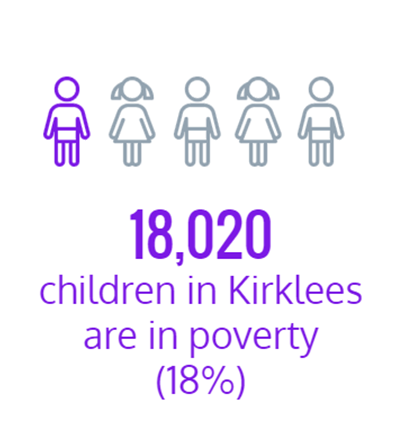 |
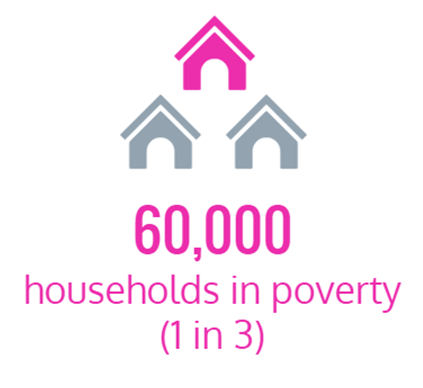 |
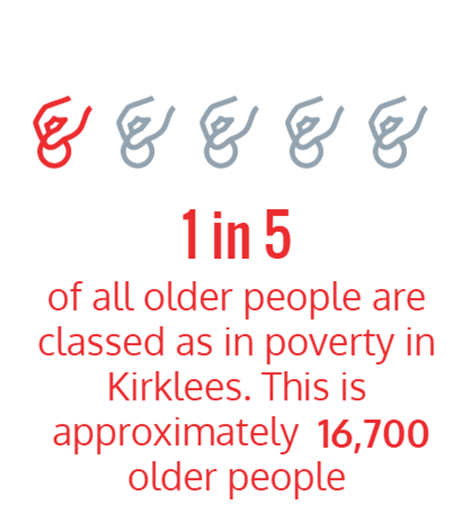 |
Poverty affects 1 in 3 households in Kirklees, with 1 in 4 households having an annual income of less than £10,000 and 1 in 5 older people classed as living in poverty (1).
11.5% of households in Kirklees are living in fuel poverty. Living in a cold home has a significant impact on both physical and mental health. There are a number of groups who are particularly vulnerable to the cold. These include people with respiratory and cardiovascular conditions, older people and children (1).
Living in poverty causes significant stress. Money worries are the most common in deprived areas and amongst people with long term conditions, adults with dependent children and adults who are economically inactive.
Around 1 in 5 children (18%) of children in Kirklees are living in poverty. Children who live in poverty suffer more persistent, frequent, and severe health problems than children who grow up under better financial circumstances (2).
Why is this issue important?
Poverty is commonly defined as either absolute or relative. Absolute poverty refers to the lack of means necessary to meet basic needs such as food, clothing and shelter. Relative poverty takes into consideration individual social and economic status compared to the rest of society. The focus of this section is relative poverty.
There has been a shift in the nature of poverty in Britain in the last decade. Whilst poverty remains a problem locally it has remained fairly stable with small reductions in pensioner poverty over the last few years (3). There is, however, an underlying issue for a larger section of the population where overall living costs have increased. This means sudden changes to income and circumstances are having a greater impact on individuals. A recent parliamentary enquiry (4) estimated that 1 in 4 people relying on food banks are in low paid work.
Many infants born into poverty have a low birth weight, which is associated with many preventable mental and physical disabilities. Not only are these infants more likely to have poor health, they are also more likely to die before their first birthday. Children living in poverty also tend to miss school more often because of illness and do not achieve as well as their peers at Key Stages 2 and 4.
Low income households are likely to experience more stress than middle‐income families. In addition to financial uncertainty, these families are more likely to be exposed to negative events including illness, depression, eviction, job loss and bereavement.
The quality of housing available to those in poverty or on low income can often be of poor quality. The Housing section talks in more detail about stock quality, but it is important that all residents are able to access and maintain decent and affordable accommodation through a range of options – home ownership, social housing and the private rented sector.
Fuel poverty
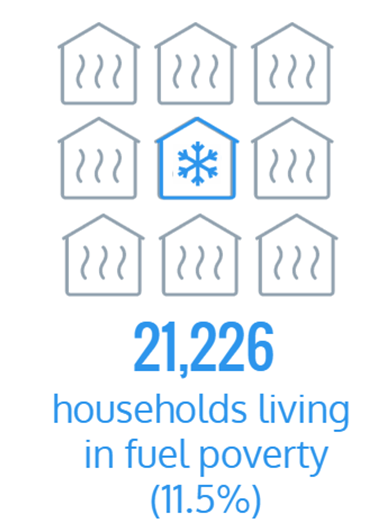 |
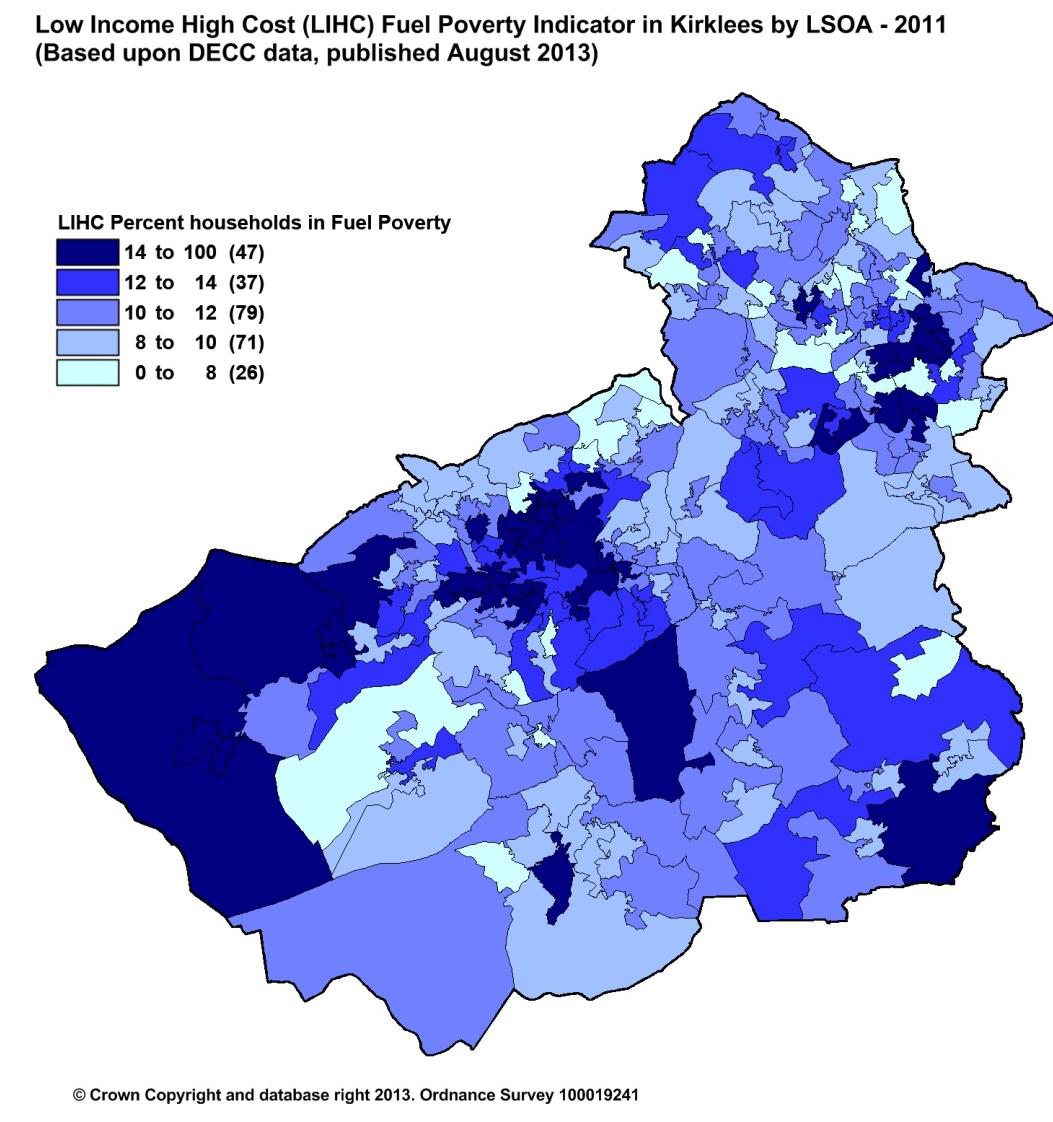 |
Fuel poverty affects 1 in 9 Kirklees households. Fuel poverty is caused by a complex range of factors:
- The energy efficiency of the property (such as effective insulation or an energy efficient heating system)
- Energy costs (the cost of gas and electricity bills for the household)
- Household income (if a household has a low income or is not claiming for benefits which they are entitled to).
The map above shows the prevalence of fuel poverty across Kirklees. This shows that fuel poverty is an issue in urban areas such as Huddersfield, Batley and Dewsbury where there greater numbers of households on a low income living in older homes which are harder to insulate effectively. There are also high levels of fuel poverty in some rural areas as there are likely to be more households which are off the gas grid and therefore paying higher fuel costs.
There are major health implications of living in cold or damp homes. This includes a greater risk of cardiovascular or respiratory conditions, a greater risk of falls for the elderly as well as impacts on emotional wellbeing such as depression, stress and anxiety.
Cold homes also have a significant impact on the ability of children and young people to live happy and healthy lives. This includes an increased risk of respiratory conditions, low weight gain in infants, a higher level of hospital admissions within the first 3 years of life and an increase in minor illnesses (5). Indirect consequences of children living in a cold home include a negative impact on educational attainment.
Food Poverty
Food poverty is about individuals, households and communities spending a larger proportion of their income on food and having less choice and reduced access to healthy food. As the cost of living increases, households often have to choose to sacrifice one expense over another. This has been described as choosing to “heat or eat” when households choose to either heat their house or eat food.
There are a number of factors which give us an understanding of the broad picture of food poverty:
- Increased numbers of people accessing food banks as a result of a range of issues including benefit sanctions.
- An increasing number of adults (66%) and children (32% at age 11) who are overweight or obese.
- In Kirklees lower income groups are less confident at cooking from scratch.
- Unhealthy food can be easier to access and cheaper to buy than a healthy alternative.
Because food poverty is so complex, people on low incomes have the lowest intakes of fruit and vegetables and are far more likely to suffer from diet-related diseases such as cancer, diabetes, obesity and coronary heart disease. Food poverty can also be about an overabundance of “junk” food in local shops and takeaways as well as a lack of healthy food (6).
For more details around Food and Food Poverty please see the Food section of the Kirklees Joint Strategic Assessment.
What significant factors are affecting this issue?
When a person lives in poverty it will influence their whole life – from their ability to buy affordable goods and financial services through to the housing they can afford. The income of a family or older person is often fixed, especially for those out of work. This means that as the cost of food and energy rise, budgets are stretched and debt can escalate.
Throughout adult life there are likely to be a number of events that can increase a person’s likelihood of slipping into poverty. This includes the loss of a job, family breakdown, bereavement and being involved in crime and the criminal justice system.
Household income
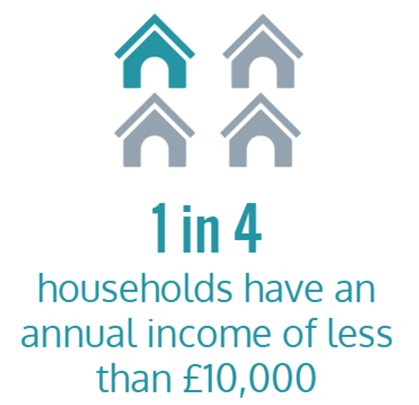
It has become harder to live a comfortable life on a low or even middle income. Roughly a third of the working-age population in Kirklees live on low to middle incomes. Although not a new problem and partly due to the impacts of the economic downturn, there has been a change to living standards in a typical working household in Kirklees.
Median full time weekly gross pay in Kirklees was £459 in September 2015. However, based on inflation, average weekly wages should be nearer £483 (7). This creates a shortfall of £1,273 per year which, alongside the increase in costs of living makes it more difficult for low income households to manage their budgets. The need to spend more on essentials leaves households with difficult decisions to make. It is often long term plans that suffer because savings or pension contributions are reduced. This leaves households vulnerable to sudden changes in circumstances such as unemployment or large household expenses.
The government has also made significant changes to the way in which people are supported financially. Those changes have meant that in many cases support is no longer available, is of a lower value or is delivered differently. Where people can respond by changing where they live, finding work or working significantly more hours, they might be able to mitigate those effects. However where people find that too challenging or the opportunities are fewer then they will need to absorb the full impact of those savings.
Borrowing and Debt
The proportion of household spending used to pay unsecured debt (any debt which is not mortgage related) has increased. Nationally it is thought that unsecured debt per household is around £11,800, which has steadily increased since 2008. It is thought households are spending on average 26.5% of income servicing these debts (8). Although Bank of England base rates have remained low, the reduced accessibility of affordable credit has pushed some households to borrow in the high cost/short term credit sector, such as payday lenders, weekly payment stores or illegal lenders.
Benefit Sanctions (9)
When people receive Jobseeker’s Allowance (JSA) or Employment and Support Allowance (ESA), there are certain requirements attached to receiving these benefits. If these are not met, sanctions can be applied in the form of stopping benefit payments for a period of time.
This means that many people experience poverty because of benefit sanctions. People will often need to use food banks to meet their immediate needs. Sanctions can also have an impact on mental health by increasing levels of anxiety and bring acute financial insecurity.
In Kirklees over 17,000 sanctions have been given since 2012. Sanction decisions can be challenged; around 1 in 5 of those sanctioned in Kirklees successfully appealed their sanction. However, even if a sanction decision is overturned, a claimant may not receive the money owed to them for some time.
Which groups are affected most by this issue?
Children – As already highlighted, the impact of poverty on children can have lifelong implications.
Working age in ill health or disabled – Those with limiting physical or mental health conditions were twice as like to be in poverty when compared to their peers (1).
Older people – Despite a reduction in the number of people in later life living in poverty, it remains an issue for a number of older people. The combination of having poor health or mobility, living in a rural area or in old housing with limited transport options can make it much harder to manage on a fixed income.
People with poor motivation to look after their health are more likely to be living in poverty than more motivated people. Poorly motivated people are also more likely to have multiple long-term conditions, risky health behaviours and poor levels of social connectedness.
Where is this causing greatest concern?
There are individuals, couples and families living in poverty throughout Kirklees.
The prevalence of child poverty ranges from 1 in 14 (7%) in Kirkburton to 1 in 3 (35%) in Newsome and Dewsbury West. Evidence shows that Dewsbury, Huddersfield, and Batley have the highest proportions of children living in income deprived households (10). Dewsbury and Batley have the highest proportion of older people who are income deprived (10).
What are the assets around the issue?
Health assets are those things that enhance the ability of individuals, communities and populations to maintain and sustain health and well-being. These include things like skills, capacity, knowledge, networks and connections, the effectiveness of groups and organisations and local physical and economic resources. They also include services or interventions that are already being provided or beginning to emerge which contribute to improved health and wellbeing outcomes.
Assets are hugely important to how we feel about ourselves, the strength of our social and community connections and how these shape our health and wellbeing.
As part of our KJSA development we are piloting a range of methods to capture and understand the assets that are active in Kirklees. Please see the assets overview section for more information about our approach and if you are interested in place-based information about assets in Kirklees have a look at the assets section in each of our District Committee summaries (Batley and Spen, Dewsbury and Mirfield, Huddersfield and Kirklees Rural). Where possible and appropriate we will provide information about local assets supporting people across different stages of the life course.
For the topic of poverty there are a growing number of organisations and schemes some of which are state funded and others which rely more on donations or support from faith groups. These organisations are working to support those in poverty or those nearing the edge of being in poverty. The support they offer can be practical with things such as food and toiletries. They also offer a route into the appeals and application process for benefits. Some schemes are able to support people with basic skills develop and job search opportunities. For more information about local support see the KJSA Assets Overview section.
Motivated individuals living in neighbourhoods where there are households living in poverty are also local ‘assets’. Such individuals can be enabled to be ‘community champions’ to provide peer support and help less motivated people to take steps to improve their circumstances by signposting them to sources of support, helping them to manage their budgets, etc.
There are developing projects in Kirklees which aim to support residents and community and third sector organisations to share their assets with each other. This includes spaces, physical resource or people skills. This helps to connect people who have a passion to improve their local area, giving everyone access to the resources they need, building trust through sharing. It also provides communities and organisations with the ability to save money as well as contribute towards a range of positive health and wellbeing outcomes. For further information please see Kirklees Shares and Comoodle.
Views of local people
Whilst there is insight from people living in Poverty at a national level, there is a gap around the views of local people in relation to their own experiences of living in poverty.
What could commissioners and service planners consider?
Commissioners, service planners and Councillors should consider local community assets such as those outlined above so that they can support and build on local strengths and also understand where there are gaps and unmet needs in particular places or amongst particular communities.
Commissioners and providers should make reference to the Tackling Poverty in Kirklees strategy in order to support their work. Particular consideration should be given to:
- Gathering insight from Kirklees residents about their experiences of living in poverty. To work with residents in order to better understand how living with overty affects their lives and the best approaches of enabling residents to live poverty free.
- Rethinking costs of living. As fuel, food and transport costs have increased across the income spectrum, commissioners and providers should consider what can be done to mitigate this locally through achieving a living wage and other work.
- Ensuring access to suitable and settled homes, providing a secure place for families to thrive and live independently.
- Ensuring an appropriate supply of good quality, energy efficient housing that supports good health and reduces living costs.
- Commissioners and service planners developing a strategic, integrated approach to tackling fuel poverty across Kirklees.
- Increasing the economic resilience of Kirklees residents. Enabling people to maximise their financial assets, to spend and borrow in the most efficient ways and to reduce the impacts of unforeseen changes to financial circumstances.
- Whilst poverty can affect a range of population groups, action should focus on those who are most affected, i.e. children, adults who are ill or disabled and older people.
References and additional resources/ links
- NHS Kirklees, Kirklees Council. Current Living in Kirklees. 2012.
- Child Poverty Unit. Child Poverty Basket of Local Indicators. 2014. Available from: https://www.gov.uk/government/publications/child-poverty-basket-of-indicators
- Joseph Rowntree Foundation. A UK without poverty. 2014. Available from: https://www.jrf.org.uk/report/uk-without-poverty
- All-Party Parliamentary Group on Hunger and Food Poverty. Feeding Britain: A strategy for zero hunger in England, Wales, Scotland and Northern Ireland. British medical journal. 2014.
- Adam S, Monaghan R. Fuel poverty: What it means for young parents and their families. 2016.
- Sustain. What is food poverty? 2013. Available from: http://www.sustainweb.org/foodaccess/what_is_food_poverty/
- Office for National Statistics. Annual survey of hours and earnings, 2015 provisional results. 2015. Available from: http://webarchive.nationalarchives.gov.uk/20160105160709/http://www.ons.gov.uk/ons/dcp171778_424052.pdf
- Bank of England. Money and Credit: November 2015 Part one: Broad money and credit. London; 2016.
- Porter C. Benefit Sanctions: A paper for the Kirklees Financial Inclusion Steering Group. 2014.
- Department for Communities and Local Government. The English Indices of Deprivation 2010: The Income Deprivation Affecting Children Index and the Income Deprivation Affecting Older People Index File Notes. 2010. Available from: https://www.gov.uk/government/uploads/system/uploads/attachment_data/file/6871/1871208.pdf
Date this section was last reviewed
11/08/16 (PL)
